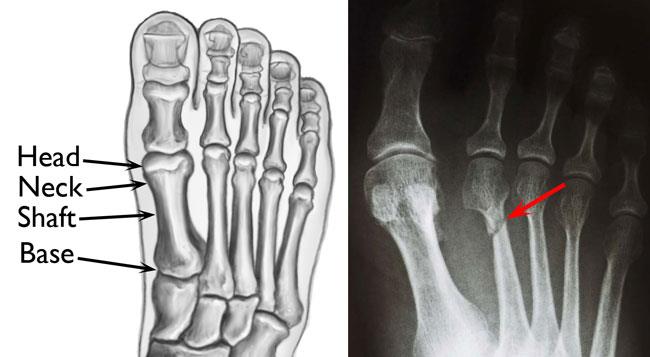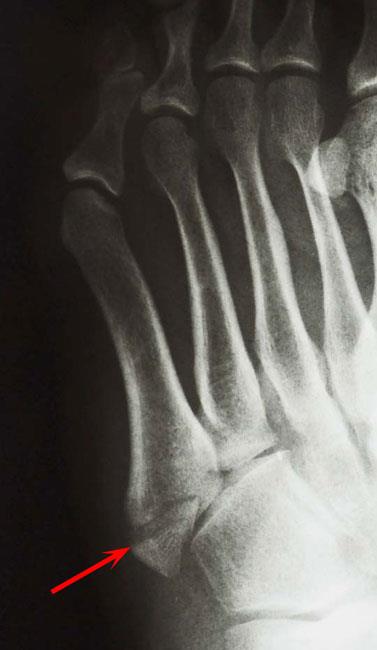Foot & Ankle
Toe & Forefoot Fracture
Toe and forefoot fractures are common injuries that involve breaks in the bones of the foot. The forefoot consists of the five metatarsal bones (the long bones in the foot) and the phalanges (toe bones).
Understanding Toe & Forefoot Fractures
These fractures can be caused by various mechanisms such as direct trauma, twisting injuries, or overuse, particularly in sports activities. The metatarsals and phalanges are particularly vulnerable, with fractures often occurring due to high-impact forces or sudden twists.
Fractures in this area can range from simple breaks that heal without the need for surgery to complex fractures that require surgical intervention. Prompt and appropriate treatment is crucial to restoring function and preventing long-term complications, such as persistent pain or difficulty walking.
Common Causes and Risk Factors
The primary causes of toe and forefoot fractures are:
- Direct Trauma: Dropping a heavy object on the foot or experiencing a blow during contact sports is one of the most common causes of fractures in this region.
- Twisting or Rotational Injuries: Stubbing the toe or a misstep during physical activity can lead to stress on the bones, causing a fracture.
- Repetitive Stress: Activities such as long-distance running or high-impact sports, including basketball and soccer, increase the risk of stress fractures, particularly in the metatarsals.
- Osteoporosis: Conditions that weaken bones, such as osteoporosis, can make the bones more susceptible to fractures, even with minimal trauma.
- Incorrect Footwear: Poorly fitting shoes, especially those with high heels or inadequate arch support, can increase the risk of injury during physical activities.

Metatarsal Fractures
The metatarsals are the long bones between your toes and the middle of your foot. Like toe fractures, metatarsal fractures can result from either a direct blow to the forefoot or from a twisting injury. Some metatarsal fractures are stress fractures caused from repetitive activity or pressure on the forefoot.


Fifth Metatarsal Fracture
The fifth metatarsal is the long bone on the outside of your foot. Injuries to this bone may act differently than fractures of the other four metatarsals. Common fractures of the fifth metatarsal include:
- Avulsion fracture (left) - through the base of the bone from an injury where the foot and ankle are twisted downward and inward. The fractured fragment is pulled away from the rest of the bone from stretching the tendon attached to the fifth metatarsal.
- Jones fracture (right) - horizontal or transverse fracture at the base of the fifth metatarsal. One of the most common fractures of the foot and has unique characteristics that make it more likely to require surgery.


Symptoms of Toe & Forefoot Fractures
The symptoms of toe and forefoot fractures depend on the severity and location of the fracture. Common symptoms include:
- Pain: Sharp pain in the toe or forefoot, especially when bearing weight on the affected foot.
- Swelling: Swelling around the affected area, which may develop immediately after the injury.
- Bruising: Discolouration in the toe or foot, particularly if significant trauma occurred.
- Deformity: In severe fractures, the affected toe may appear misaligned, or there may be a visible bump or abnormal positioning of the toe or foot.
- Difficulty Walking: Difficulty walking or bearing weight on the injured foot due to pain and instability.
- Tenderness: Pain upon touching the fractured area, which is typically localised to one specific spot on the foot.
If you experience these symptoms, it's essential to seek medical attention promptly for accurate diagnosis and treatment. Early intervention can significantly improve recovery outcomes.
Diagnosis of Toe & Forefoot Fractures
Dr. Ryan du Sart will conduct a detailed clinical examination to assess the extent of the injury. This includes examining the injured area for deformities, pain, and swelling. In addition to the physical examination, Dr. du Sart may recommend imaging tests, such as:
- X-rays: The primary imaging tool for diagnosing fractures in the toes and forefoot. X-rays help confirm the type of fracture and its location.
- CT Scan: In cases of complex fractures, a CT scan may provide a detailed view of the bone and joint structure.
- MRI: If there is concern about soft tissue damage (such as tendon or ligament involvement), an MRI may be recommended to assess the extent of the injury.
Treatment Options for Toe & Forefoot Fractures
Treatment depends on the severity and type of fracture, as well as the patient's activity level. Dr. du Sart offers both non-surgical and surgical treatment options, ensuring a tailored approach for each individual patient.
Non-Surgical Treatment (For Mild to Moderate Fractures)
For many toe and forefoot fractures, non-surgical treatment can be highly effective. These non-invasive approaches may include:
- Buddy Taping: For simple fractures of the toes, the affected toe may be taped to the adjacent toe to provide stability and support while healing.
- Rest and Immobilisation: Resting the foot and immobilising the injured area with a cast, walking boot, or stiff-soled shoe is essential to prevent further injury and allow proper healing.
- Ice and Elevation: Applying ice to the affected area for 20 minutes at a time, multiple times a day, helps reduce swelling and pain. Elevating the foot also aids in swelling control.
- Pain Management: Pain relievers, such as paracetamol or NSAIDs, are commonly used to manage pain and inflammation.
- Physical Therapy: Once the bone has healed sufficiently, a structured rehabilitation program will be recommended to restore strength, flexibility, and balance in the foot.
Surgical Treatment (For Severe or Non-Healing Fractures)
For more severe fractures or fractures that do not heal with non-surgical treatment, surgery may be required. Surgical options include:
- Internal Fixation: This procedure involves the use of screws, plates, or wires to stabilise the bone fragments and allow the fracture to heal correctly. Minimally invasive techniques can often be used to reduce recovery times.
- Bone Grafting: In cases of severe fractures or significant bone loss, a bone graft may be required to encourage healing and restore normal bone structure.
Dr. du Sart uses advanced, minimally invasive surgical techniques to reduce recovery times and improve surgical outcomes for patients undergoing toe and forefoot fracture repairs.
Post-Operative Care and Recovery
Recovery times vary depending on the severity of the fracture and the treatment approach. However, the typical recovery timeline includes:
- Initial Immobilisation: The injured foot may need to be immobilised for several weeks to promote proper bone healing. During this phase, Dr. du Sart may recommend using crutches or a knee scooter to avoid weight-bearing.
- Gradual Weight-Bearing: Once healing has progressed, patients will begin to gradually introduce weight-bearing activities with the help of a walking boot or stiff-soled shoe.
- Physical Therapy: Rehabilitation exercises are vital to restore strength, flexibility, and range of motion. Physical therapy will help you return to daily activities and prevent future injuries.
- Return to Activity: Depending on the severity of the fracture, patients can usually resume normal activities within 6–12 weeks. Athletes may need additional rehabilitation before returning to high-impact sports.
Preventing Future Injuries
Preventing future toe and forefoot fractures is crucial, particularly for individuals involved in high-impact activities. Dr. du Sart recommends the following prevention strategies:
- Proper Footwear: Supportive, well-fitted shoes are essential for protecting the feet during physical activities and preventing fractures.
- Strengthening Exercises: Strengthening exercises for the feet and legs can improve balance and stability, reducing the risk of fractures.
- Gradual Increase in Activity: If you're increasing your level of physical activity, do so gradually to avoid overuse injuries.
- Foot Care: Regular check-ups with a podiatrist or orthopaedic surgeon can ensure your feet remain healthy and free from conditions that could increase the risk of fractures.
Why Choose Dr. Ryan du Sart?
Dr. Ryan du Sart is a highly experienced orthopaedic surgeon with extensive expertise in treating toe and forefoot fractures. His commitment to patient-centred care and personalised treatment plans ensures that every patient receives the best possible care, from diagnosis to rehabilitation.
Book a Consultation
If you have suffered a toe or forefoot fracture or are experiencing persistent foot pain, early intervention is key to a successful recovery. Schedule a consultation with Dr. Ryan du Sart today to explore your treatment options and get back to your normal activities.
Phone: (08) 9779 9767
Email: admin@ryandusart.com.au
Locations:
6 Higgins Street, South Bunbury, WA 6230
20 Prince Street, Busselton, WA 6280
References:
- American Academy of Orthopaedic Surgeons (AAOS). (2020). Foot fractures.https://www.aaos.org
- Cleveland Clinic. (2021). Toe fractures.https://my.clevelandclinic.org/health/diseases/21538-toe-fracture
- Journal of Foot and Ankle Surgery. (2019). Management of forefoot fractures.https://www.jfas.org
- Royal Australian College of Surgeons (RACS). (2020). Foot fractures and management.https://www.surgeons.org

